This week’s blog entry is a big update on what I’ve been working on this week in the game, which is a combination of graphics, inventory systems, limbs and player health, and allowing for lightning (e.g. torches) external to the player. Firstly, I’ve been implementing graphics for various items. One of these is bottles – whilst the game does not contain “potions”, it’s going to be important to be able to transport various liquids. I currently plan for this to be possible via glass bottles, and waterskins, with each balanced a little differently – glass bottles can hold anything, but might be smashed in combat, whilst waterskins can only hold one substance (as it soaks into the material – so you cannot use it for poison, then water), but cannot be destroyed in combat. Although not a key component of 0.4, I decided a day or two ago to work on the bottle graphics, since I was taken by some of the ideas I had, and here’s what I came up with. Firstly, below, are four examples of possible substances in four different types of bottle. The top-left is water, the top-right is oil (notice the subtle sheen?), the bottom-left is blood (the most stylized of the bunch), and the bottom-right is poison.
There are currently five different shapes of bottle (all shown below, though I might add a sixth too) – these shapes have no gameplay effect, but are just for variation. Each has five different levels for the substance inside – full, three-quarters full, half full, one-quarter full, and empty. Once empty you will be able to refill them from an appropriate source (like blood from a corpse, water from a river, poison from a deactivated poison trap, etc). There are, as above, currently only four substances, though I can imagine several others that might be useful in the future. There are therefore at the moment exactly a hundred different permutations of glass bottles (5 designs, 5 levels, 4 substances). Thus far this is the highest number of permutations to date, I think, for any particular graphic, and will only continue to grow as I add another type of bottle and various other substances.
I’ve also remade the inventory (for the final time). The inventory in 0.3 is effectively a “fake” inventory – you can only pick up the three key segments, and you cannot drop them, and only one aspect of the inventory can be accessed. Additionally the system for picking up wasn’t “real”, in the sense that the items were implemented in a way which couldn’t really support anything other than the three key segments. This entire system has now been changed in several ways. Firstly, when you try to pick up an item on a tile with more than one item, it produces a list of possible items (shown below).
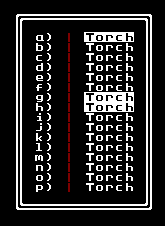
You can then highlight the ones you want by pressing the appropriate letter, and press Enter to confirm your selections. Those are all then added to the appropriate inventory sections. The inventory itself, meanwhile, can now handle, sort and allow you to select arbitrary items from any category. When you open your inventory categories with > 0 items in will appear white rather than grey. Also, opening your inventory for different purposes – looking, dropping, using, etc – will obviously have a different label. You then select the appropriate inventory subgroup and do whatever it is you opened the inventory for. Esc or any movement key will get you out of this screen.When you select an inventory sub-group, it then brings up a list of everything in that subgroup. I debated just having one large inventory for all items, but I decided against that for various reasons. Firstly, because some inventory classes have limitations – for instance, you will only be able to carry one long weapon with you – and I felt this needed to be clear. Secondly, some inventory categories might have large numbers of similar items, for example lots of branches for making torches, and I didn’t want that to “clog up” other inventories. Thirdly I suppose it also serves a small gameplay effect for showing you what category certain items fall into, and fourthly, I just felt having a “main” inventory menu looked aesthetically nicer. I did a lot of practice with it and much like one becomes used to doing several-stage macros in Nethack or Crawl, so to does one quickly become used to clicking the shortcut to the right inventory area.

One of the items I’ve now implemented graphics for is the torch, which looks like this:
Torches have five different images which reflect how burnt down they are (0-20%, 20-40%, and so on), and there is also a different colour of wood for each type of branch (the above being olive, and 20-40% burnt), resulting in something like eighty different torch images or so. I am currently in the process of adapting and balancing the extent to which I want torches to boost your vision, and also to allow the player to make torches via the new ‘m’ake command. “Crafting” will not be a large part of the game, but there will be a few situations where you will be able to combine items to others. I’ll have more on this screen and this mechanic once I’ve worked on it a bit more, but you’ll soon be able to use flint, stone and a tree branch to create a torch (i.e. creating a spark with which to light the branch). Over the next week or two I’ll be looking to implement the difference in torch radius when you wield a torch, and allow you to wield and un-wield them. You can also now drop items, either singly or in large numbers, much like the pick-up-multiple-items menu; you are given a list, you highlight the ones you want, then press enter.Next up I’ve been working on the health and limb system, which has undergone a not insignificant number of changes over the lifetime of the game thus far. I’m implementing this now because traps need to be able to hurt you (funnily enough) which means that acid burns, fire burns, physical limb damage and all the rest of it need implementing. The first part of this is ensuring that limbs all display correctly when you look the player (and later at other foes). This can either be done by ‘l’ooking at yourself, or pressing the ‘@’ button. Here’s a quick preview of how the three screens currently look (they can be tabbed between) which you can click to view larger:
The second and third screen are largely placeholders at the moment, since you cannot change your clothes/weapons nor gain or lose any allegiances aside from the civilization and religion you start off belonging to. The first screen, however, now displays whatever dreadful ailments have befallen your character, as in the example below:
And also, as we can see, whatever healing items have been applied. I’ll do a full blog entry later on how health and healing are going to work since this entry is getting long enough already, but items like bandages, sutures and splints are going to be important to healing various parts of the player’s anatomy. Also, you really don’t want the rotting status.Lastly I’ve also worked on external lighting sources, though they are still very much a work in progress. When you drop a lit torch, it currently lights up an area around the player (the radius is not yet fixed or decided; this is just a proof-of-concept example). If you can see the external light source, you will be able to see everything in it, as in the left picture. In the right version, there is a tree trunk between you and the light source; you can therefore see parts of it, but not all of it. You will not be able to see creatures or items between you and an external light source if there is a gap between the two – whilst obviously in the real world you would see a silhouette, I think it would make for more interesting gameplay if you could only see foes when they’re in lit areas, thereby perhaps allowing you to place and move light sources strategically to keep track of enemies.
What I’m not yet sure about though is the relationship between external light sources and undiscovered terrain. In this example below, although you haven’t explored the middle you can still see through it to some of the light source, but since parts of it are blocked, you can reasonably deduce there is probably a tree or two in the shroud you cannot yet see. This model treats undiscovered areas the same as areas you’ve discovered but cannot currently see – you can see through them, but you cannot see into them.
Whilst I think the first two implementations both make sense, I’m really not sure about this one, so leave thoughts on whether you think this makes sense, or whether undiscovered terrain should totally block your line or sight. I can see arguments for both versions.
That’s quite enough for this week – next week I’ll probably be moving onto discussing either traps, limb damage, or both, in more detail, but as ever let me know what you think of these latest steps towards 0.4! As a whole, things are well on track for a winter release, and now that I actually have a working microphone again, I’ll be looking to stream more coding sessions and Q&As and the like in the near future – stayed tuned to Twitter & Facebook for details…
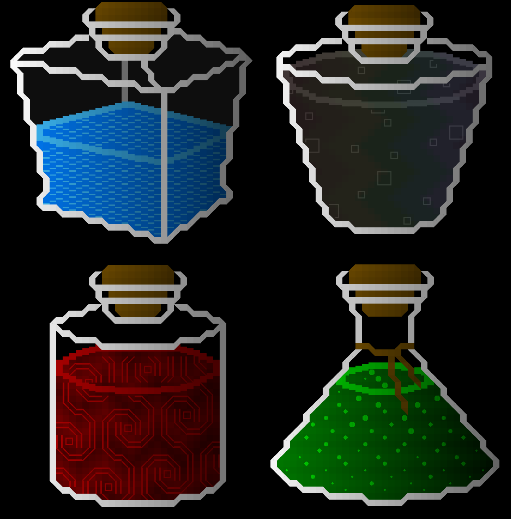
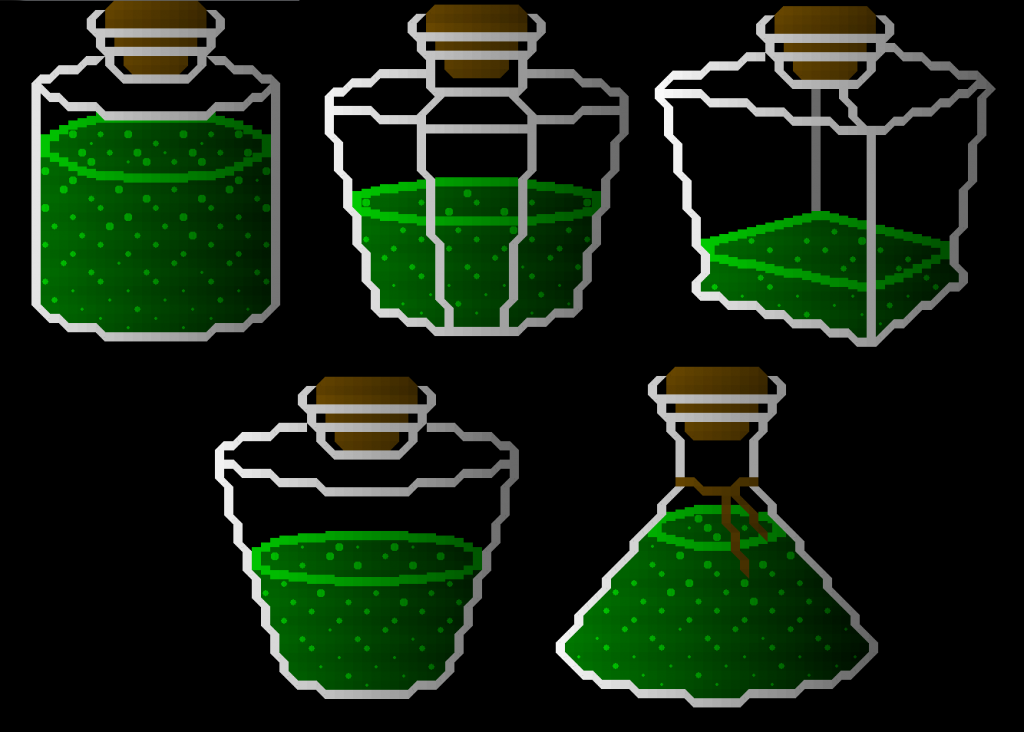
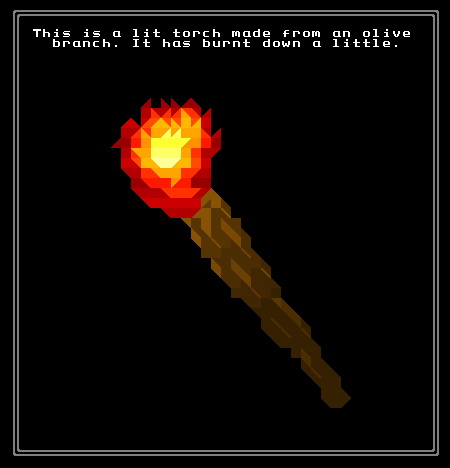
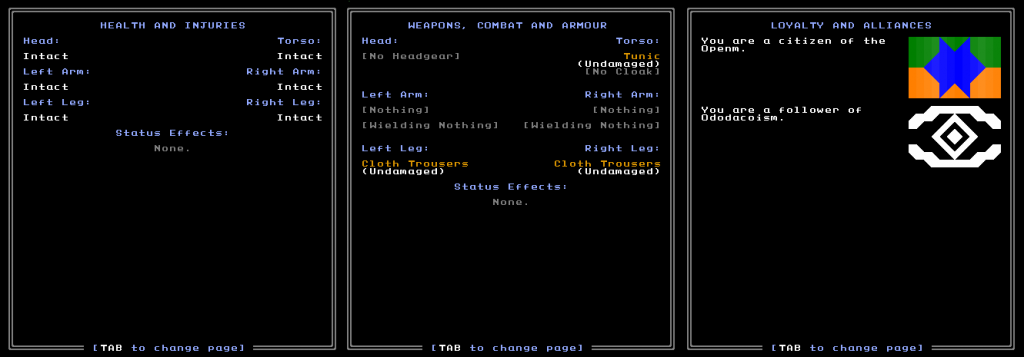
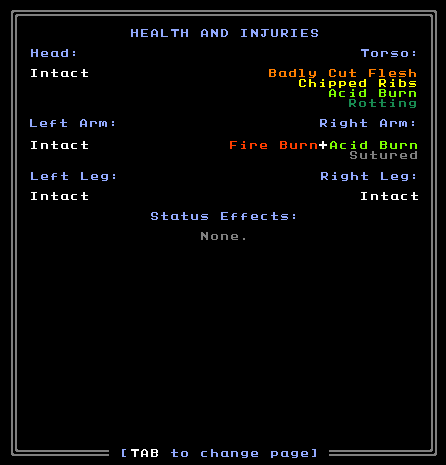
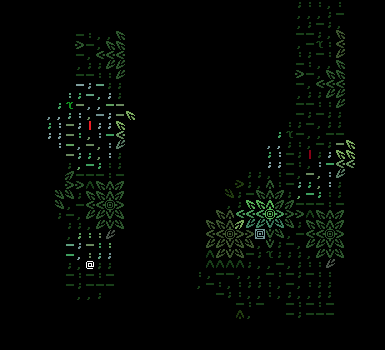
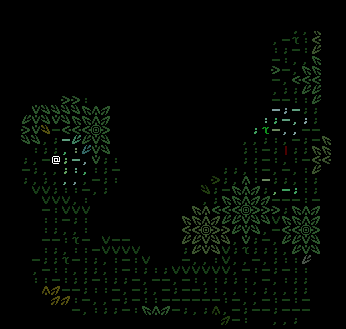

I'm not sure I understood what you are getting at in that last section on visibility -- not a good sign. Visibility in strategy games should be intuitive.
You could have three levels of visibility during the night:
1) Area close to light source AND within range of vision, is shown as visible.
2) Area that has not been visited yet is shown as completely black (undiscovered)
3) Area that has been visited previously (you walked through it while holding a torch, or walked through it earlier, during daylight) but is currently out of range of vision, and or in the dark, is shown as all-grey tiles.
If I played a game, the 3 rules above would make sense immediately, and require no explanation.
Also, I think liquids saturating the inside of a flask made from leather is an unnecessary complication. A glass vessel that contained poison would have to be washed and rinsed before it could be used for water. I think just have certain liquids in glass bottles (perfume, poison, blood) and others in leather flasks (water, wine) and leave it at that, so if you want to safely transport certain liquids you have to move them by cart, or risk breakage.
I hope this feedback is helpful and has encouraged you to keep working on your game. I know if I wrote such detailed updates and no-one commented I would feel a little forlorn. ;-)
What I was trying to describe is, I think, exactly what you've just described! The 1/2/3 stages you wrote are exactly how it works currently. My question was rather whether you should be able to see "through" *undiscovered* terrain to see torch-lit areas in that same way you can see through *discovered-but-not-currently-in-vision-range* areas. But nevertheless, I am pleased to say it does follow the exact three rules you wrote, it's just that last issue I'm debating the pros and cons of.
I disagree re: unnecessary complication - I know realism-wise a glass bottle would indeed have to be cleaned, but I think the difference I suggested would make for a quite simple little balancing act between the two. I have been thinking about how you'll be able to transport more items (pack horse?), but I haven't yet decided on how that'll work.
It is, very :). Thanks for the feedback on both counts; I'll be keeping updating roughly once a week as I finish off working on 0.4. I have been somewhat delayed temporarily by introducing my laptop to a large quantity of water, but normality should resume soon...